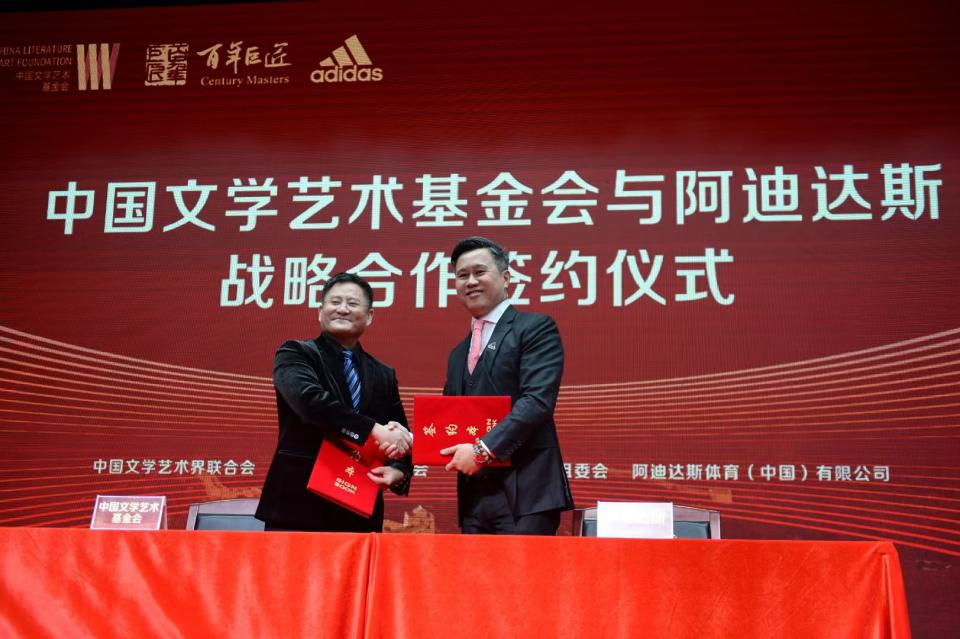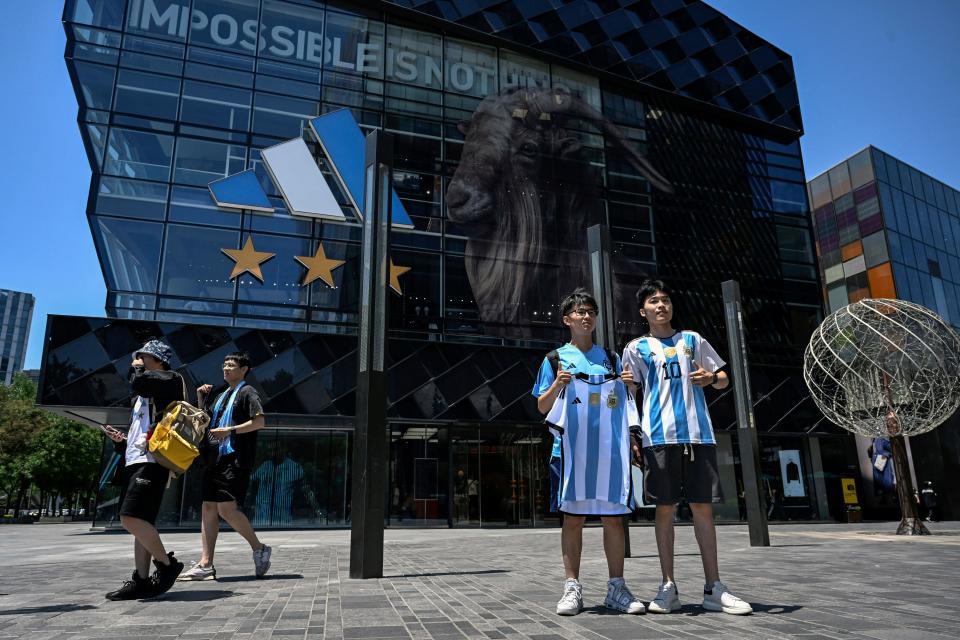Adidas China Chief Adrian Siu Details Turnaround Plan, Localization Strategies

SHANGHAI — When Adidas‘ local manufacturing and franchise partners arrived at the brand’s spring summer 2024 trade show, they were welcomed by an outsized Chinese slogan that can be directly translated as “Adidas still got it.”
With wholesale sales still a big chunk of the business, Adidas’ closed-door “brand show,” one of the largest since China slashed COVID-19 restrictions, hosted more than 2,000 vendors at a Wuhan sports stadium.
More from WWD
The slogan, albeit modest in tone, portrayed the candid stance that the German sportswear giant is actively taking in the market, where it hopes to be rebranded as a “In China, for China” company, according to Adrian Siu, the company’s Greater China chief for the past year.
Siu, who has served in multiple roles for Adidas in Hong Kong and Shanghai, was most recently the chief executive officer of Cosmo Lady, China’s largest underwear maker.
A major task for Siu is to rework the brand as “one of the most profitable markets” for Adidas in the long run, as Adidas’ new CEO Bjørn Gulden noted during the company’s first-quarter earnings call.
After the BCI controversy, coupled with COVID-19 lockdown woes and the Yeezy crisis, the company’s Greater China arm has been on a losing streak for seven consecutive quarters. Last year, sales in the market plunged 36 percent to 3.2 billion euros, just half of 2019 levels.
For the first quarter of this year, revenue in the Greater China market continued to fall by 9 percent, but the company highlighted sell-out growth, or the amount of Adidas goods sold through its retail partners, which resumed “double-digit growth” in the period.
Increased competition from domestic players has made it harder for Adidas to engineer a quick turnaround.
Last year, Anta surpassed both Nike and Adidas to become the biggest sportswear brand by revenue in China. A brand synonymous with Chinese pride, the market gains prompted Anta company chairman Shizhong Ding to become the richest man in the country’s apparel business. According to the local ranking platform “New Fortune 500,” Ding’s wealth reached 90.3 billion renminbi, or $12.6 billion, in 2023.
At Adidas, a gloomy outlook persists. At the group level, the company expects currency-neutral revenues to decline at high-single-digit rates due to “uncertainty around the China recovery,” revenue lost from unsold Yeezy inventory, macroeconomic challenges and geopolitical tension.
But the soft-spoken Siu remains confident that Adidas can ride the tailwind of a burgeoning sportswear market in China driven by policy incentives and change of lifestyles post-lockdown.
Based on Euromonitor estimates, China’s sportswear apparel market is expected to grow by 10.5 percent to 401 billion renminbi, or $55.9 billion.
Adidas remains a market leader, in particular in the premium category, accounting for 11.2 percent of China’s sportswear market in 2022, according to data from Euromonitor.
Numbers aside, Siu has spent the last year rebuilding Adidas’ relationship with Beijing while pushing a patriotic-driven clothing line.
In November, not long after German Chancellor Olaf Scholz’s Beijing visit, the company signed a strategic agreement with the Chinese Literature and Art Foundation, which will materialize in a series of documentaries that pay tribute to the nation’s sports heroes and pioneers. A partnership with Chen Xiao, a Chinese actor, will help bring the program to grade schools around the country.

At the Wuhan trade show, an army of models showcased the latest collection from the kung fu master-inspired Wuji collection, as well as Adidas’ iconic tracksuits with “China” splashed across them in Chinese.
The message for 2024 already rang loud and clear: “Adidas appreciates Chinese culture, respects the Chinese consumer, and wants to support and promote sport in China so that everyone in China can have the power to change life and become healthier,” Siu reiterated during an interview with WWD in Shanghai.
Asked about how Adidas plans to go head-to-head with rising local sporting goods giants, most notably Anta, Siu continued to enthuse about Adidas’ chance to further engage with Chinese consumers and Chinese athletes on all fronts.
“I was so happy to see our tennis player Wang Xinyu win the French Open women’s doubles yesterday. It’s a first for China,” said Siu. “We are ready, we are prepared, and we welcome the competition, as long as it is healthy competition.”
Apart from Wang, Adidas is quickly adding more local athletes to its fold. The brand has signed Wu Yibing, the first Chinese player to win an ATP title, and the 17-year-old Chinese breakdancer Liu Qingyi, who Siu is betting on to be a star athlete at next year’s Paris Olympics.
A boost to the brand’s logo came this week in Beijing as the Adidas-sponsored Lionel Messi is due to play a friendly football match against Australia on Thursday at the Bird’s Nest Stadium, the capital city’s outsized venue. But to Messi fanatics’ dismay, a scheduled meet-and-greet at Adidas’ Sanlitun Beijing flagship was canceled at the last minute due to safety concerns. Per local media reports, the need to “stay away from commercial activities” was also a part of the consideration.

More localized collections are also in the works. Siu revealed to WWD exclusively that Adidas will launch a collaboration with Chinese designer Rui Zhou, who’s known for her ultra-sexy knitwear, on a movement and dance-focused collection.
A snowboarding apparel line designed by Chinese snowboarder and Olympic champion Su Yiming will be introduced later this year.
Despite news circulating on Chinese social media that a linkup with Edison Chen and his streetwear label Clot is due to be unveiled this fall, Siu declined to comment.
“I’m not allowed to answer this, but I can tell you that we will work with a lot of great talents. They have very strong intellectual power in both the cultural and sneaker circles,” said Siu.
Adidas is also doubling down on speed-to-market via Consumer Creation Shanghai, or CCS team. The 80-person market research and design team is responsible for creating products that answer directly to Chinese consumer needs and can churn out new releases in a time frame that ranges from a few weeks to three months, depending on material availability.
“If we want to win in the market today, I think we also need to increase our speed, become more agile, more responsive, and have a better balance between supply and demand,” said Siu.
The new athleisure line Adidas Sportswear has been a major testing ground for the CCS team, which has been performing “up to expectations” since products hit the shelves in March.
The plan is to design at least 30 percent of all Adidas products sold in China locally, up from a figure in the low single digits three years ago.
With a new travel craze centered around camping and embracing the great outdoors — the market is projected to reach around $14 billion by the end of 2023, according to Tmall — the CCS team is planning to add more talent to double down on outerwear that can compete with a rising number of global and homegrown outdoors brands.
Siu is still gazing into the crystal ball to gauge when Adidas will become relevant and cool again, but recent linkups with luxury and fashion labels, including Prada, Balenciaga, and Gucci, help. Case in point: its most recent collaboration with Grace Wales Bonner unexpectedly created a “liquid silver” frenzy on Xiaohongshu, with mentions topping the 240,000 mark. The metallic Samba style quickly sold out on Adidas Original’s Confirmed app.
In the short run, Siu would like to focus on more small, even unexpected wins like this.
“We want to have a more long-term sustainable business in China. We are in a marathon, not a sprint,” said Siu. “We still have many, many years in the market. We want to win the hearts of Chinese consumers, but first, we need to keep improving our products, our storytelling, and our speed to market.”
Best of WWD

